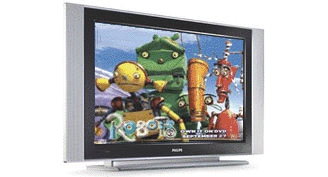 PC as
TV and PVR
PC as
TV and PVR
 PC as
TV and PVR
PC as
TV and PVR
(June, 2005)
Every now and then I’ll come across an article on the future convergence of
computers and home entertainment systems. It seems like experts on both sides
of the aisle expect this to happen, but the ‘when’ part has been elusive. We’ve
already seen some early examples of this confluence of technologies. Microsoft
has had a less-than-successful run with their WebTV product (now sold as MSN
TV2). Folks who want to time shift their TV viewing are turning to TIVO units,
which forsake VCR tape and employ a computer-like hard drive to store digital
signals. And Microsoft is on the third iteration of its Windows XP Media Center
operating system, which adds TIVO-like capabilities and a remote control to its
standard operating system. Probably the most common response a consumer makes
upon considering this merging of computing and home entertainment is “Great,
just what we need – a television that has to be rebooted several times a day.”
I recently took a foray into this world of converging technologies on a small scale when I added a TV tuner card to my PC. This is an add-on circuit board that consumes one of the open PCI slots inside my computer. (You can get other models that do not require opening your PC case – they connect via a USB port and cable.) After doing the requisite research, I elected to purchase a Hauppage PVR150 card. There are both cheaper and pricier alternatives to the Hauppage card, but after reviewing several enthusiasts’ web sites, it became clear that this was the brand of choice. They make several different models. At around $90, the PVR150 is near the bottom of their price structure, but it had all the features I wanted. It employs something called hardware MPEG decoding; cheaper alternatives (which start at around $30) let software do the MPEG decoding, which consumes system resources big-time. With hardware encoding you can actually use this card on relatively modest speed computers, as long as you have a few gigabytes of available hard drive space. The card comes with a remote control, a necessity if you really plan to use your PC for any serious TV viewing.
Which brings us to the really hard question: why on earth would anyone want to watch television on their PC? Is ‘Survivor’ all that hot when viewed within a postcard sized window? Is there some secret interactive functionality available when watching ‘The Simpsons’ on a 17” screen?
No doubt my wife’s quick answer would be because I can’t pull myself away from that stupid computer to even watch TV. OK, so there might be a kernel of truth to that. But my reasoning was that we were about to move into a new house where the PC will live in a den that is too small to accommodate a standard television. This provided an excuse to seek permission to upgrade to a 20” LCD screen with the thought that the PC could double as a television with the addition of the TV tuner card. And further, I just like to explore new computer technologies. The experience gained puts me in a position to offer aid, advice, and comfort to those similarly afflicted.
So how does it work? I would say that as far as installation, my out-of-the-box experience was positive. The card and software installed without a glitch. I just plugged in a standard 75 ohm TV cable from the wall outlet that connects me to Cox Cable, installed the TV tuning interface software, and with a couple of mouse clicks to answer some where-am-I questions, I was up and running with the full gamut of cable stations at my disposal. As to picture quality, I had read that most TV tuner cards for PCs were disappointing in that regard, so I was not surprised to find clarity in full-screen mode well short of what we enjoy on a dedicated TV screen. I would put clarity at between 80 and 90 percent, with windowed screens much clearer than full-screen view.
I mentioned that the model I purchased was the PVR150. “PVR” stands for Personal Video Recorder”. This package is the equivalent of a TIVO unit, without the subscription fee and at a fraction of the price. I can record a show as I watch, or I can set the timer to record a show in the future. The program is saved to the PC’s hard drive. You can select the quality level to record at, and match it to your available drive space. Decent quality recording consumes about 3GB per viewing hour. And like a TIVO unit, if you get a phone call while watching a show on your PC, you just click on the Record button, go take your call, and when you come back you can resume watching where you left off while the unit continues to record in present time. And yes, there is a commercial-skip option.
If you have an interest in TV tuner cards or PVRs in general, there are several websites where you can get lots of good user advice. Check out http://www.byopvr.com (the Build Your Own PVR site) which is a must-see site for those contemplating any TV/PVR hardware or software. Also visit http://www.htpcnews.com (Home Theater PC News), and the foreboding sounding http://www.cask-of-amontillado.com. The user forums at http://www.shspvr.com are excellent.
With any luck, by the time you read this, I’ll be in my new den, posting checks to my Quicken software while a small window on the screen keeps me posted on whether Rachael Ray is able to enjoy three sumptuous meals in her next port of call on $40 A Day.